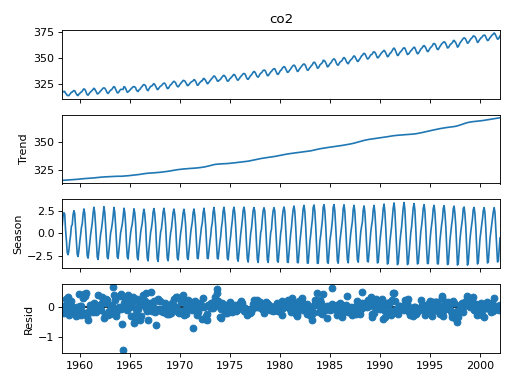statsmodels.tsa.seasonal.STL¶
- class statsmodels.tsa.seasonal.STL(endog, period=None, seasonal=7, trend=None, low_pass=None, seasonal_deg=1, trend_deg=1, low_pass_deg=1, robust=False, seasonal_jump=1, trend_jump=1, low_pass_jump=1)¶
Season-Trend decomposition using LOESS.
- Parameters:¶
- endogarray_like
Data to be decomposed. Must be squeezable to 1-d.
- period{
int,None},optional Periodicity of the sequence. If None and endog is a pandas Series or DataFrame, attempts to determine from endog. If endog is a ndarray, period must be provided.
- seasonal
int,optional Length of the seasonal smoother. Must be an odd integer, and should normally be >= 7 (default).
- trend{
int,None},optional Length of the trend smoother. Must be an odd integer. If not provided uses the smallest odd integer greater than 1.5 * period / (1 - 1.5 / seasonal), following the suggestion in the original implementation.
- low_pass{
int,None},optional Length of the low-pass filter. Must be an odd integer >=3. If not provided, uses the smallest odd integer > period.
- seasonal_deg
int,optional Degree of seasonal LOESS. 0 (constant) or 1 (constant and trend).
- trend_deg
int,optional Degree of trend LOESS. 0 (constant) or 1 (constant and trend).
- low_pass_deg
int,optional Degree of low pass LOESS. 0 (constant) or 1 (constant and trend).
- robustbool,
optional Flag indicating whether to use a weighted version that is robust to some forms of outliers.
- seasonal_jump
int,optional Positive integer determining the linear interpolation step. If larger than 1, the LOESS is used every seasonal_jump points and linear interpolation is between fitted points. Higher values reduce estimation time.
- trend_jump
int,optional Positive integer determining the linear interpolation step. If larger than 1, the LOESS is used every trend_jump points and values between the two are linearly interpolated. Higher values reduce estimation time.
- low_pass_jump
int,optional Positive integer determining the linear interpolation step. If larger than 1, the LOESS is used every low_pass_jump points and values between the two are linearly interpolated. Higher values reduce estimation time.
Notes
Derived from the NETLIB fortran written by [1]. The original code contains a bug that appears in the determination of the median that is used in the robust weighting. This version matches the fixed version that uses a correct partitioned sort to determine the median.
See the notebook Seasonal Decomposition for an overview.
References
[1]R. B. Cleveland, W. S. Cleveland, J.E. McRae, and I. Terpenning (1990) STL: A Seasonal-Trend Decomposition Procedure Based on LOESS. Journal of Official Statistics, 6, 3-73.
Examples
The original example uses STL to decompose CO2 data into level, season and a residual.
Start by aggregating to monthly, and filling any missing values
>>> from statsmodels.datasets import co2 >>> import matplotlib.pyplot as plt >>> from pandas.plotting import register_matplotlib_converters >>> register_matplotlib_converters() >>> data = co2.load(True).data >>> data = data.resample('M').mean().ffill()The period (12) is automatically detected from the data’s frequency (‘M’).
>>> from statsmodels.tsa.seasonal import STL >>> res = STL(data).fit() >>> res.plot() >>> plt.show()(
Source code,png,hires.png,pdf)
Methods
fit([inner_iter, outer_iter])Estimate season, trend and residuals components.
Properties
The parameters used in the model.
The period length of the time series